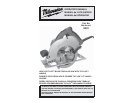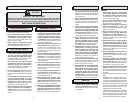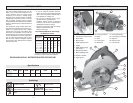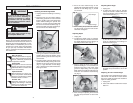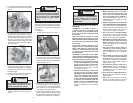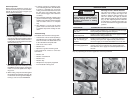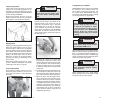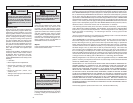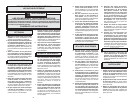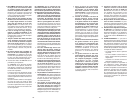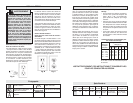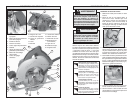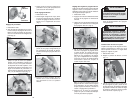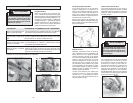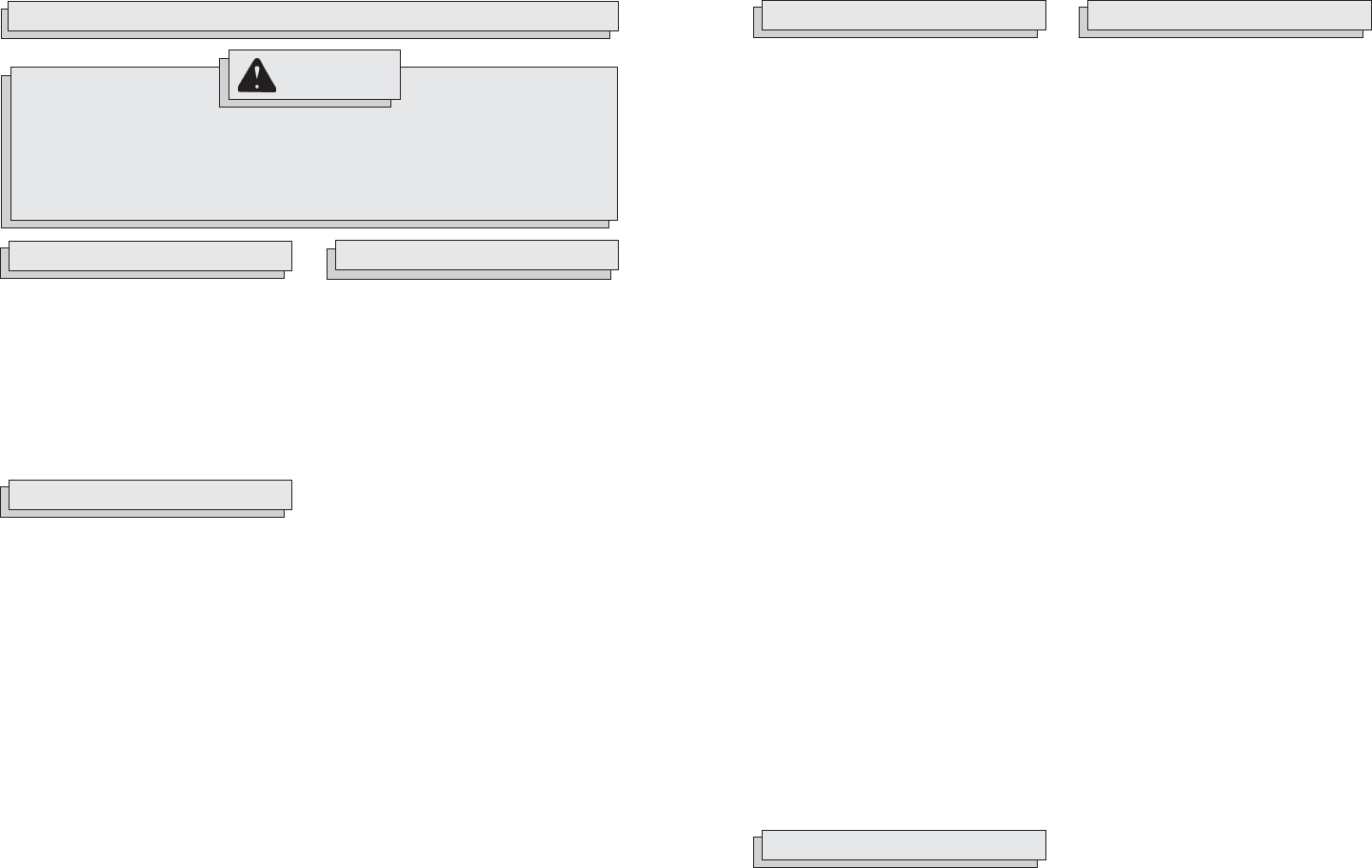
2 3
WORK AREA SAFETY
ELECTRICAL SAFETY
PERSONAL SAFETY
WARNING
READ ALL INSTRUCTIONS
Failure to follow all instructions listed below may result in electric shock, fi re and/or
serious injury. The term “power tool” in all of the warnings listed below refers to your
mains-operated (corded) power tool or battery-operated (cordless) power tool.
SAVE THESE INSTRUCTIONS
GENERAL SAFETY RULES — FOR ALL POWER TOOLS
1. Keep work area clean and well lit. Clut-
tered or dark areas invite accidents.
2. Do not operate power tools in explosive
atmospheres, such as in the presence
of fl ammable liquids, gases, or dust.
Power tools create sparks which may
ignite the dust or fumes.
3. Keep children and bystanders away
while operating a power tool. Distrac-
tions can cause you to lose control.
4. Power tool plugs must match the
outlet. Never modify the plug in any
way. Do not use any adapter plugs
with earthed (grounded) power tools.
Unmodifi ed plugs and matching outlets
will reduce risk of electric shock.
5. Avoid body contact with earthed or
grounded surfaces such as pipes,
radiators, ranges and refrigerators.
There is an increased risk of electric shock
if your body is earthed or grounded.
6. Do not expose power tools to rain
or wet conditions. Water entering a
power tool will increase the risk of electric
shock.
7. Do not abuse the cord. Never use the
cord for carrying, pulling, or unplug-
ging the power tool. Keep cord away
from heat, oil, sharp edges, or mov-
ing parts. Damaged or entangled cords
increase the risk of electric shock.
8. When operating a power tool outdoors,
use an extension cord suitable for
outdoor use. Use of a cord suitable for
outdoor use reduces the risk of electric
shock.
9. Stay alert, watch what you are do-
ing and use common sense when
operating a power tool. Do not use
a power tool while you are tired or
under the infl uence of drugs, alcohol
or medication. A moment of inattention
while operating power tools may result
in serious personal injury.
10. Use safety equipment. Always wear
eye protection. Safety equipment such
as dust mask, non-skid safety shoes,
hard hat, or hearing protection used
for appropriate conditions will reduce
personal injuries.
11. Avoid accidental starting. Ensure the
switch is in the off-position before
plugging in. Carrying power tools with
your fi nger on the switch or plugging
in power tools that have the switch on
invites accidents.
12. Remove any adjusting key or wrench
before turning the power tool on. A
wrench or a key left attached to a rotat-
ing part of the power tool may result in
personal injury.
13. Do not overreach. Keep proper foot-
ing and balance at all times. This
enables better control of the power tool
in unexpected situations.
14. Dress properly. Do not wear loose
clothing or jewellery. Keep your hair,
clothing and gloves away from moving
parts. Loose clothes, jewellery, or long
hair can be caught in moving parts.
15. If devices are provided for the connec-
tion of dust extraction and collection
facilities, ensure these are connected
and properly used. Use of these de-
vices can reduce dust-related hazards.
POWER TOOL USE AND CARE
16. Do not force the power tool. Use the
correct power tool for your applica-
tion. The correct power tool will do the
job better and safer at the rate for which
it was designed.
17. Do not use the power tool if the switch
does not turn it on and off. Any power
tool that cannot be controlled with the
switch is dangerous and must be re-
paired.
18. Disconnect the plug from the power
source and/or the battery pack from
the power tool before making any
adjustments, changing accessories,
or storing power tools. Such preven-
tive safety measures reduce the risk of
starting the power tool accidentally.
19. Store idle power tools out of the
reach of children and do not allow
persons unfamiliar with the power
tool or these instructions to operate
the power tool. Power tools are danger-
ous in the hands of untrained users.
20. Maintain power tools. Check for
misalignment or binding of moving
parts, breakage of parts and any
other condition that may affect the
power tool’s operation. If damaged,
have the power tool repaired before
use. Many accidents are caused by
poorly maintained power tools.
21. Keep cutting tools sharp and clean.
Properly maintained cutting tools with
sharp cutting edges are less likely to
bind and are easier to control.
22. Use the power tool, accessories and
tool bits etc., in accordance with
these instructions and in the manner
intended for the particular type of
power tool, taking into account the
working conditions and the work to
be performed. Use of the power tool for
operations different from those intended
could result in a hazardous situation.
SERVICE
23. Have your power tool serviced by a
qualifi ed repair person using only
identical replacement parts. This will
ensure that the safety of the power tool
is maintained.
SPECIFIC SAFETY RULES
DANGER:
1. Keep hands away from cutting area
and the blade. Keep your second hand
on auxiliary handle, or motor housing.
If both hands are holding the saw, they
cannot be cut by the blade.
2. Do not reach underneath the work-
piece. The guard cannot protect you from
the blade below the workpiece.
3. Adjust the cutting depth to the thick-
ness of the workpiece. Less than a full
tooth of the blade teeth should be visible
below the workpiece.
4. Never hold piece being cut in your
hands or across your leg. Secure the
workpiece to a stable platform. It is
important to support the work properly to
minimize body exposure, blade binding,
or loss of control.
5. Hold power tool by insulated gripping
surfaces when performing an opera-
tion where the cutting tool may contact
hidden wiring or its own cord. Contact
with a “live” wire will also make exposed
metal parts of the power tool “live” and
shock the operator.
6. When ripping always use a rip fence or
straight edge guide. This improves the
accuracy of cut and reduces the chance
of blade binding.
7. Always use blades with correct size
and shape (diamond versus round) of
arbour holes. Blades that do not match
the mounting hardware of the saw will run
eccentrically, causing loss of control.
8. Never use damaged or incorrect blade
washers or bolt. The blade washers and
bolt were specially designed for your saw,
for optimum performance and safety of
operation.
9. Causes and Operator Prevention of Kick-
back:
KICKBACK is a sudden reaction to a
pinched, bound or misaligned saw blade,
causing an uncontrolled saw to lift up and
out of the workpiece toward the operator.
When the blade is pinched or bound tightly
by the kerf closing down, the blade stalls
and the motor reaction drives the unit
rapidly back toward the operator.
If the blade becomes twisted or misaligned
in the cut, the teeth at the back edge of the
blade can dig into the top surface of the
wood causing the blade to climb out of the
kerf and jump back toward the operator.



